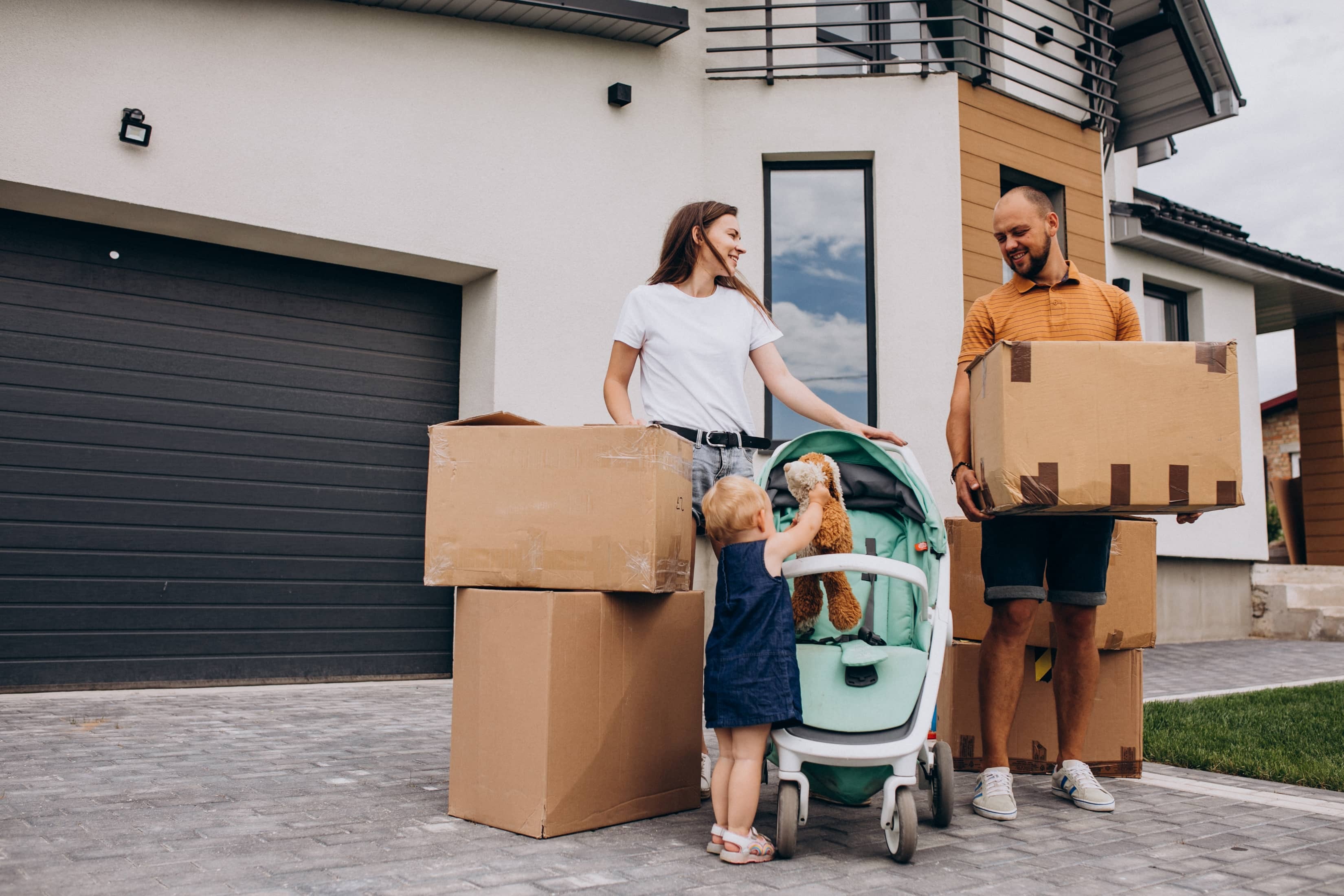The average occupancy rate for self storage facilities is 96.5%, meaning there’s a big demand for storage. Additionally:
Over one-fifth of renters in the U.S. use self storage.
These businesses have around 70% net operating income (NOI).
In the UK, there has been an average rental return increase of £26.23 per square foot in the last year.
If you’re going to invest in a self storage facility, design and layout are crucial to your success and are the first factors you should consider.
Your chosen design impacts the customer experience, especially when it comes to convenience. It also influences how many self storage units you can offer and what you can charge, impacting profitability.
In this article, we’ll cover everything you need to consider when it comes to your self storage facility design for a seamless customer experience.
What Is Self Storage Design and Why Is It Important?
Source: Freepik
Self storage design is the strategic planning, layout, and architectural considerations that go into creating a functional, secure, and profitable facility.
It involves:
➡️ Optimizing how you use your space.
➡️ Ensuring ease of access.
➡️ Incorporating security features.
➡️ Enhancing the customer experience.
➡️ Meeting regulatory and zoning requirements.
The design process considers factors such as unit configurations, traffic flow, building materials, environmental considerations, and operational efficiency.
You should prioritize your self storage design for the following reasons:
👉 Maximizing space and revenue: A well-designed facility optimizes the use of your available land, ensuring that as many rentable units as possible can fit within the space. Proper layout planning prevents wasted space and maximizes your return on investment (ROI).
👉 Enhancing customer experience: Easy access to units with wide driveways, ample parking, and logical layouts makes your facility more user-friendly. Well-lit, clearly marked walkways help customers navigate your facility efficiently.
👉 Security and safety: A good design incorporates surveillance cameras, gated access, and proper lighting to enhance security. Safe layouts minimize blind spots where theft or accidents could occur.
👉 Climate control and storage conditions: Facilities designed with proper ventilation, insulation, and climate-controlled units prevent damage to stored items. Protecting belongings from extreme temperatures and humidity increases customer satisfaction.
👉 Operational efficiency: Strategic placement of office spaces, elevators, and loading zones improves workflow for staff and customers. Automated systems, such as keyless entry, online bookings, and smart locks also streamline operations.
How to Start Designing Your Self Storage Site
Source: Freepik
Now that you know more about why design and layout are essential for your facility, let’s look at three steps you should start with when it comes to developing your site:
1. Conduct a site survey
You should conduct a thorough site survey to assess the land’s suitability for self storage buildings. The location is crucial to your facility’s success, influencing demand, accessibility, and overall profitability.
The first consideration is land size and shape. A flat, rectangular lot is ideal because it allows for efficient building layouts and drive aisle configurations. Sloped or irregularly shaped land may require extensive grading, which can increase your construction costs.
You should also assess soil conditions to determine if the land can support the foundations of your buildings or containers without expensive reinforcement.
Accessibility and visibility are also crucial. A site that is highly visible from a main road and easily accessible via major highways will attract more customers.
Adequate space for entrances, exits, and wide driveways is also necessary for smooth traffic flow.
Additionally, you should check for utility connections, including electricity, water, and sewer lines, to ensure the site can accommodate your infrastructure.
2. Do your research on zoning and code
Zoning laws and building codes vary by location, and operators must ensure their facility complies with all local regulations before proceeding with design and construction. Failing to do this can lead to costly delays or even prevent your project from moving forward.
Check zoning designations for your property, as not all land is zoned for self storage use, and some areas impose restrictions on the size, height, or type of facility that can be built.
Zoning regulations also dictate setbacks, meaning how far the building must be from the road, neighboring properties, or natural features like wetlands.
You also need to consider building codes, including fire safety regulations, stormwater management, and compliance with the Americans with Disabilities Act (ADA) in the U.S. or the Equality Act 2010 in the UK.
3. Determine your unit mix
Once you’ve found the right site, you need to determine the ideal mix of storage unit types and sizes. Your goal should be to maximize rentable space while catering to customer demand.
Self storage facilities contain an average of 546 units each, with nearly 20% of these properties offering parking and storage for boats and RVs.
Your unit mix should be based on market research and competitor analysis. You should evaluate the most popular unit sizes in your area and identify gaps in the market.
Common unit sizes include small lockers (5’x5’), standard units (10’x10’ or 10’x15’), and large garage-style spaces (10’x30’).
Urban facilities may focus more on smaller, climate-controlled units, while residential areas often include larger drive-up spaces.
Understanding customer demographics is also crucial. Smaller units will likely be in demand if the area has a high percentage of apartment dwellers. In contrast, regions with many homeowners or businesses may require larger units.
Additionally, college towns may need short-term student storage, while coastal areas may have demand for boat and RV storage.
What to Consider When Designing Your Self Storage Facility
Source: Freepik
There’s plenty to take into account when designing your facility to ensure you can maximize profitability. Let’s unpack some of the main considerations:
🤔 Outdoor vs. indoor self storage
You would need to decide whether to design an outdoor or indoor facility, and this decision should be based on demand, available space, and customer needs.
Outdoor self storage
Outdoor self storage typically consists of drive-up units that allow customers to park directly in front of their storage space, making loading and unloading quick and convenient.
Indoor self storage
Indoor self storage, on the other hand, provides added protection for weather conditions and typically includes climate-controlled units. This appeals to customers storing sensitive items like documents, electronics, or furniture.
While indoor facilities require more investment in HVAC systems, elevators, and security, they often attract higher-paying customers who prioritize convenience and safety.
🤔 Single-story vs. multi-story
The decision between single-story and multi-story storage depends on factors such as land availability, construction costs, and target market preferences.
Single-story self storage
Single-story facilities are generally easier for customers and staff to navigate, as they provide direct, drive-up access to units without the need for elevators or staircases. They also tend to be more cost-effective in terms of maintenance and construction.
Multi-story self storage
Multi-story storage facilities are more suited to high-density urban areas with limited and expensive land. They allow operators to maximize rentable space vertically, offering more units within a smaller lot.
These facilities often include elevators, loading docks, and climate control, increasing customer appeal but leading to higher construction and operating costs.
🤔 Containers vs. permanent structures
You’ll need to decide whether to use container self storage or traditional buildings when you design your facility.
One of the primary reasons you need to weigh this up is the difference in upfront costs and construction requirements.
Container self storage
Container storage is a more affordable option for operators because it repurposes shipping containers, reducing the need for expensive construction. You can purchase new or used containers, place them on a prepared site, and begin renting them out quickly.
Permanent self storage buildings
On the other hand, buildings require significant upfront investment in construction, materials, and permitting. Traditional self storage buildings, whether single-story or multi-story, involve site preparation, foundation work, and structural engineering.
However, while these facilities take longer to build and cost more, they offer long-term durability, higher customer appeal, and more options for customization.
🤔 Entry and exit points
Efficient entry and exit points are crucial for smooth traffic flow and accessibility. To prevent congestion and confusion, a well-designed storage facility should have clearly marked entrances and exits.
Ideally, your facility should offer separate entry and exit points, particularly for larger properties or those accommodating moving trucks and commercial vehicles.
Security gates with keypads, access cards, or mobile app-based entry systems can help control entry and exit access, ensuring convenience.
You should also consider lane width and vehicle turning space, especially if you’re catering to larger trucks or moving vans.
🤔 Aisles
The width and layout of your aisles play a significant role in the functionality of a self storage facility.
Drive aisles must be wide enough to accommodate vehicles, especially in outdoor facilities where customers need space to use trucks and trailers.
For indoor storage, hallways should be wide enough to allow your tenants to move large items in and out of their units comfortably.
The placement of doors and unit layouts should be optimized to reduce congestion, especially near elevators and loading docks.
🤔 Security
Security is one of the most important considerations in self storage facility design, as customers need to feel confident that their belongings are protected.
A well-secured facility includes:
➡️ Perimeter fencing.
➡️ Controlled gate access.
➡️ High-resolution surveillance cameras.
➡️ On-site staff or security personnel.
In addition to exterior security, individual unit security is also critical. Smart locks, unit alarms, and motion sensors can add an extra layer of protection.
🤔 Lighting
Adequate lighting is another way to enhance security and improve the customer experience within your facility.
Exterior lighting should cover all entry and exit points, driveways, and perimeter fencing. LED lighting with motion sensors is energy-efficient and provides better visibility for surveillance cameras.
Interior lighting is essential for hallways, stairwells, and loading zones. Well-lit indoor facilities reduce the risk of accidents and create a more inviting environment for customers.
You should also consider installing emergency lighting to ensure safe navigation during power outages.
🤔 Amenities
By incorporating amenities at your storage facility, you can differentiate yourself from your competitors and attract more customers. In fact, about one-third of self storage facilities offer truck rentals as an amenity.
For example, you could provide covered loading and unloading areas to protect customers from harsh weather conditions.
Other customer-friendly amenities include free moving carts and hand trucks to help with heavy lifting.
Complimentary Wi-Fi, restrooms, and vending machines also enhance the overall customer experience.
🤔 Retail space
A well-planned self storage facility can generate additional revenue by incorporating a small retail space that sells items like moving and packing supplies.
Customers often need boxes, tape, bubble wrap, and mattress covers when storing their belongings. Offering these items on-site provides convenience and an additional income stream for operators.
The retail area should be located near the front office to encourage purchases and establish your facility’s brand image as one that provides one-stop storage solutions.
🤔 Vehicle storage
If you want to offer vehicle storage at your facility, you’ll need to carefully plan space for cars, boats, RVs, and motorcycles.
Outdoor storage is the most common and cost-effective option, but covered and indoor storage provides added protection against the elements and appeals to customers storing high-value vehicles.
🤔 Curb appeal
The exterior appearance of your self storage facility plays a crucial role in attracting customers and establishing a strong brand presence.
A clean, modern design with professional signage and landscaping creates a positive first impression. The building’s color scheme, materials, and architectural style should also align with the surrounding environment while maintaining a professional look.
A well-maintained entrance with paved driveways and landscaping helps instill trust in potential customers. Investing in an attractive and inviting exterior can set your facility apart from competitors, particularly in areas with multiple storage options.
What to Do Once You’ve Designed Your Facility
The design and layout of your facility are crucial to maximizing space and revenue, enhancing the customer experience, and improving operational efficiency.
Once you’ve designed and developed your facility, the next step is to use Stora’s storage facility maps feature to manage your new business.
Our next-level self storage facility maps include:
✅ A bird’s eye status summary: You can review your entire facility at a glance without having to jump between systems or screens.
✅ Point and click management: Swiftly change a unit’s status, assign it to a tenant, or pull up its rental history with convenient controls.
✅ Real-time updates: You’ll always see an up-to-date occupancy breakdown and your map update instantly when you change a unit’s status.
✅ Simple setup: Using a simple drag-and-drop feature, you can create site maps. Our team can also develop your maps for you.
With Stora, you’ll streamline facility management, reduce admin time, and provide a seamless experience for your customers—all in one intuitive platform. Book a demo today to see how Stora can help you run your facility more efficiently.







